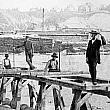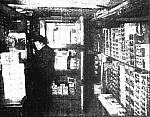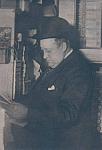Underground River: Fact
Under a section of ground on which Grand Rapids is built flows a subterranean river, and aside from its mouth and its source almost nothing of its wandering passage is known. It existed before the city came and is presumed to have been, in the early days, what was known as the east channel of Grand River. It ran between the east mainland and two islands (Nos. 1 & 2), which long ago were merged with the mainland and became the foundation of Pearl Street, the business block, and factories south of Pearl Street.
 The little arm of the river that ran between those two islands and the mainland proved to be an expensive body of water for the city. No one knew just where it ran once the city had been built over it, and the only warning that the city had was the crumbling of pavements.
The little arm of the river that ran between those two islands and the mainland proved to be an expensive body of water for the city. No one knew just where it ran once the city had been built over it, and the only warning that the city had was the crumbling of pavements.
The stream probably ran from Erie Street under the Nelson Matter furniture factory at Canal St. and Lyon St., then below the Exhibitors Building at the SW corner of Lyon and Campau. It continued under the Pantlind Hotel, Pearl Street, Louis Street, and eventually rejoined the main stream.
Unfortunately, as the early settlers began filling the channel and constructing walls, the stream was left to cause trouble in later years. In some cases it was only boarded over, and in others bricked and boarded. Over the years the bricks loosened, the boards rotted away, and parts of the top of the race had fallen in. Repeated warnings from the city engineer’s office failed to arouse city officials to a proper appreciation of the situation until the Spring of 1903 when Campau St. began to settle. Parts of the pavement fell in and when it was discovered that the stream was nine feet deep, fourteen to eighteen feet across, and rushing in a swift torrent, the danger was apparent.
So little was known about what it would cost to repair the damage that when the Board of Public Works advertised for bids, not a single bid was received. Contractors were afraid to touch it. It was left to the city to tackle the project.
Loads of dirt, taken out of Campau St., were piled fourteen feet high on top of the brick pavement as far as Pearl St. That wasn’t enough and more loads were removed. Both sides of Lyon St. were lined from Canal to Campau St. with piles of earth ten feet high.
When the workmen finally reached the stream they had opened a space two hundred feet long and twenty feet wide showing the bad parts of the masonry twenty-two feet below. The old gates to the race had long since become useless. Because it was impossible to turn off the water, the engineer had to build a coffer dam. The water was finally turned aside and repairs began.
Excerpted from the October 17, 1903 Grand Rapids Press, page 9
The Grand Rapids Press, June 6,1908, page 13, documents an underground river on the West Side that the city engineers had to deal with.

 facebook
facebook






